Fixed Bridges versus Removable Partial Dentures
Replacing Lost Tooth
Surely, if you are missing teeth, both fixed bridges and removable partial dentures are common options for replacing teeth. Our teeth play an important role in speaking, chewing, and maintaining the proper alignment of our other teeth. Certainly, there are many reasons for tooth loss, but if you do lose teeth, replace them to maintain proper chewing function. Accordingly, if you are missing one or more teeth, be aware of their importance to your appearance and dental health. Because your teeth work together for many daily functions from eating to speaking, with missing teeth, it is difficult to do these things. Missing teeth can cause speech disorders due to the many sounds we use to speak clearly.

Additionally, having gaps in your smile affects your bite, your speech, and your appearance. Regardless, replace your missing teeth. Again, if you are missing teeth, both fixed dental bridges and removable partial dentures are common options for replacing teeth. Obviously, which one is best for you depends on your oral health and your lifestyle. Undoubtedly, here at Family Dentistry Springfield, our experts are best qualified to help you make this decision.
Basics of Permanent (Fixed Bridges) versus Partial Dentures (Removable Bridges)
Overall, a bridge is a device used to replace missing teeth. It attaches artificial teeth to adjacent natural teeth, called abutment teeth. Bridges are either permanently attached (fixed bridges) or they can be removable partial dentures (removable bridge).
Your dental health is the most important reason for a bridge. Teeth complement each other. Basically, unusual stresses placed on the gums and other oral tissues when teeth are missing, causes a number of potentially harmful disorders.
Increased risk of gum disease has proven to be one of the worst side effects of missing teeth and can be minimized with a bridge.
Fixed Bridges (aka Fixed Partial Dentures)
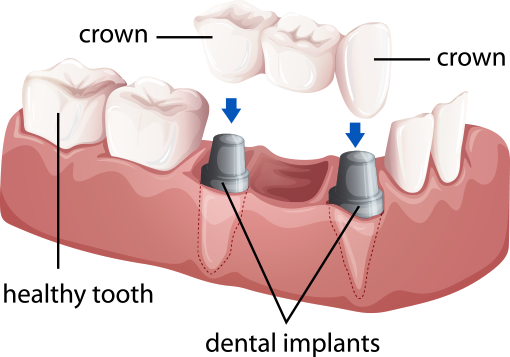
Fixed bridges are a great way to restore your dental health and appearance. Dental bridges are artificial teeth which are permanent restoration attached in your mouth. We call this kind of restoration a bridge because it bridges the gap between your existing teeth. They are most often secured by being bonded or cemented to neighboring teeth.
A bridge (fixed partial denture) is a device that fills the gap where teeth are absent. Fixed bridges bonded need dental professionals to remove. Removable bridges, as the name implies, allow for easy cleaning. Thus, fixed bridges offer more stability than their removable counterparts.
Fixed bridges applied either by placing crowns on the abutment teeth or by bonding the artificial teeth directly to the abutment teeth.
A dental bridge is a fixed appliance that spans the space where one or more teeth lost, with crowns on either end to anchor it. A typical bridge consists of an artificial tooth flanked by two crowns, which fit over prepared neighboring teeth.
These crowns placed on adjacent, healthy teeth, with the prosthetic tooth suspended between them.
Oral functionality and appearance are important reasons for wearing a bridge. A bridge helps support your lips and cheeks. Further, the loss of a back tooth may cause your mouth to sink and your face to look older.
Fixed Bridges Process
To personalize your dental bridge, we take impressions of your teeth and gums and send them to a professional lab for fabrication. When your prosthetic is ready, we secure it in place and make sure it fits comfortably.
If there are no stable neighboring teeth or multiple teeth are missing, bridges are sometimes attached to dental implants. Bridges made from gold, metal alloys, or porcelain and additionally constructed from gold alloys, non-precious alloys, porcelain, or a combination of these materials. Porcelain is bonded to either a precious or non-precious metal. Which material used, depends on your preference and our recommendation.
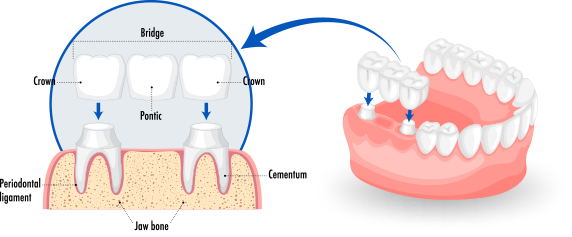
The attachment procedure usually takes two or three appointments to complete. At the first appointment, the dentist prepares the teeth on either side of the gap by removing a portion of the enamel and dentin.
Since the bridge is fabricated precisely to ensure the correct bite and to match the opposing tooth, impressions of the teeth are sent to a lab where it is constructed. Fixed bridges are typically cemented to the natural teeth next to the space left by the missing tooth. A pontic (false tooth) replaces the lost tooth. Crowns, cemented onto the natural teeth, provide support for the bridge.
Caring for Your Fixed Bridges
To care for your bridge, a strict regimen of brushing and flossing keep the bridge and surrounding teeth clean. This is of critical importance as the bridge relies on the neighboring teeth for support.
Advantages of Fixed Bridges
- Artificial teeth in a dental bridge look and feel exactly like your natural teeth. They also improve the appearance of your smile.
- When fixed in place, they provide a stable bite allowing you to chew and speak confidently.
- They are a fixed option that provides stability while being an economical alternative to dental implants.
VERSUS
Removable Partial Denture (Removable Bridge)
A removable partial denture (removable bridge), on the other hand, is a removable appliance that replaces some natural teeth. Removable bridges attach to the teeth with metal clasps or by precision attachments.
A removable partial denture is an artificial tooth appliance used to replace one or several missing teeth and is attached to remaining teeth with metal clasps. These dentures are removable to allow for easy cleaning. The base of removable partial dentures is usually made of acrylic or metal. The gums made from acrylic, and the artificial teeth made from acrylic or porcelain.
Process of a Removable Partial Denture
Your dentures designed by Family Dentistry Springfield to best fit your specific needs. Because they require use of soft tissue and remaining teeth, prior to removable partial denture fitting, a thorough examination determines if dental work is necessary.
These prosthetics used when several teeth are missing in either the upper or lower jaw. Traditional partial dentures use metal or ceramic clasps as anchors attached to adjacent teeth. The prosthetic teeth attached to a customized acrylic base made to match the color of your natural gum. Further, partial dentures are very economical and offer a dependable long-term solution for replacing missing teeth.
Additionally, partial dentures not only fill the space left by extracted teeth but also prevent nearby teeth from shifting. Partial dentures serve as an effective restoration, ultimately saving you time and money. Full dentures restore your smile when no healthy teeth remain in the upper or lower dental arches.
Both partial dentures and full dentures are custom-made to fit your unique smile. The first step is to take digital impressions of the mouth. The professional dental lab uses this information to craft your prosthetics with skill and precision.
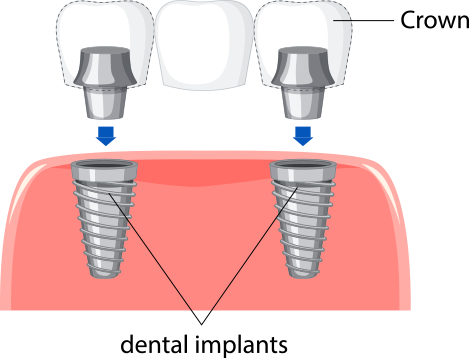
Implant-Supported Bridge
Dentures have been a dependable method for replacing missing teeth for many years. They allow you to chew food effectively and smile comfortably. The modern advancements in today’s dentistry have led to even more effective materials, as well as additional replacement options, such as denture appliances supported by dental implants.
Just like a denture that replaces an entire arch of teeth, a partial denture removed for easy cleaning while sleeping. Another difference is that partial dentures usually include both artificial gums made from pink acrylic mounted into false teeth. Bridges are just the teeth. A partial denture attached in your mouth uses clasps or precision attachments that clip on to your natural teeth.
Which One is Right for You?
These treatments can replace and restore individual missing teeth or multiple ones.
If you have several teeth in a row that are missing, the dentist is more likely to recommend a partial denture. However, if only one or two are missing, a bridge may be more appropriate. Another big factor is the dentist’s predictions about your dental health in the future. If there is a chance that you may lose more teeth, it makes less sense to attach a restoration to existing teeth. In this case, the dentist may opt for the partial denture.

While these are the basics you need to know, there are more detailed factors regarding your oral health that we may need to consider when replacing missing teeth. Any treatment we recommend will be customized to your situation and we gladly answer any questions you may have about the details of our dental bridge or partial denture treatments.
Fixed Bridges Before & After Images
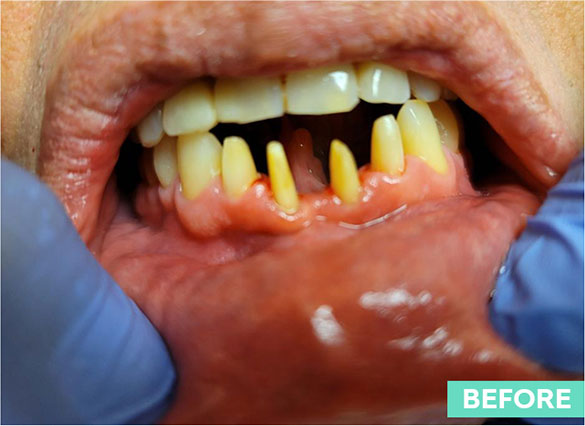
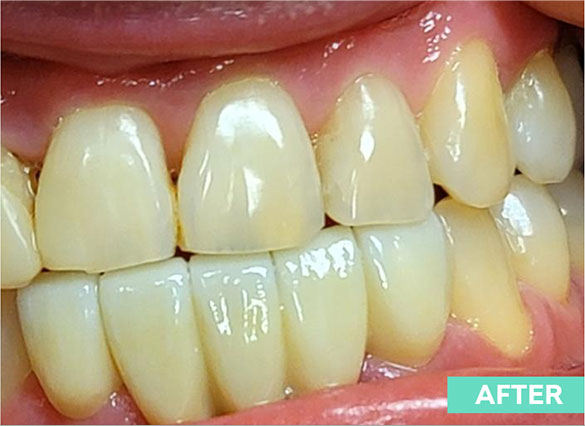
Patient came to the office with broken bridge and was told he has to remove his front teeth. But, our dentist saved his teeth and restored his oral health to the patient’s satisfaction.